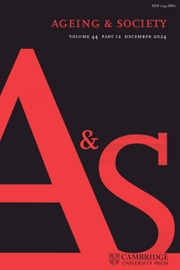No CrossRef data available.
Article contents
Ageing and technology in the policy discourse on public services digitalisation: a missed opportunity?
Published online by Cambridge University Press: 25 September 2025
Abstract
This study addresses a critical gap in research on public services digitalization, specifically, how technology’s role and its relationship with ageing are framed within policy discourse. While digitalization holds the promise of enhanced accessibility, streamlined bureaucracy and greater transparency, it also has the potential to exacerbate social exclusion in ageing societies. Macro-level factors such as policy frameworks and societal values play a key role in either mitigating or intensifying these risks; they shape the way critical issues are defined and which responses are deemed conceivable. The study aims to critically examine how digitalization and ageing are framed in European and Italian policy documents, and assess the implications of these narratives for older adults. Methodologically, it analyses a corpus of 29 European and Italian policy documents on public service digitalization (2010–2023). Keywords extraction identified ten documents for critical discourse analysis, which revealed a dominant narrative of technological optimism where digitalization is presented as a universal solution, with limited acknowledgment of its potential downsides. At the European level, some documents recognize the rights of older adults, though such recognition remains sparse. Italian policies, in contrast, tend to prioritize technical and economic aspects, with little or no attention to digital exclusion or inequality. This study sheds light on how policy discourse can obscure structural inequalities and calls for more inclusive, reflective approaches to digitalization in ageing societies. It argues that policy discourse should be leveraged not only to promote innovation but also to foster social change and reduce exclusion among older adults.
Information
- Type
- Article
- Information
- Copyright
- © The Author(s), 2025. Published by Cambridge University Press.

